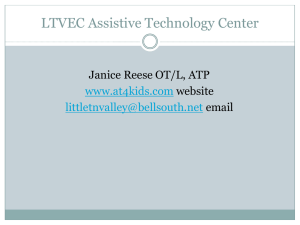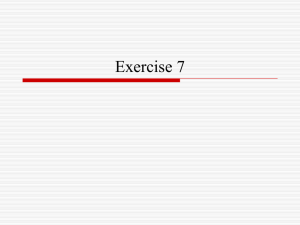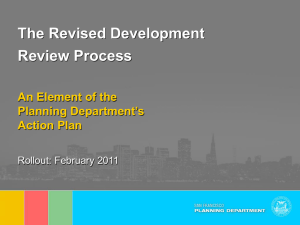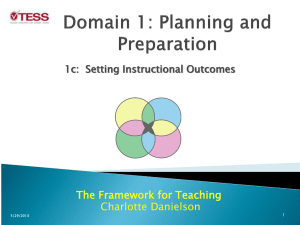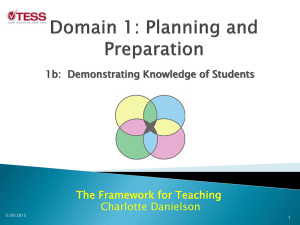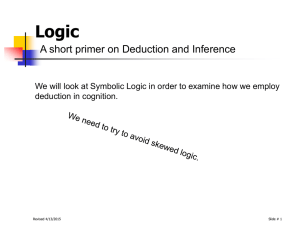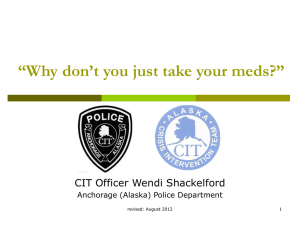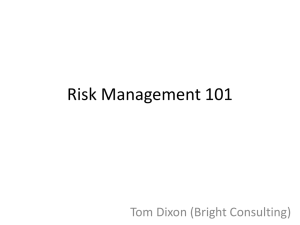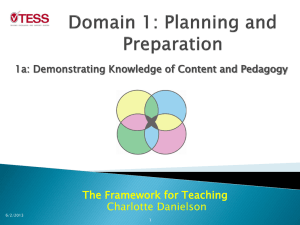PowerPoint - Arkansas Department of Education
advertisement
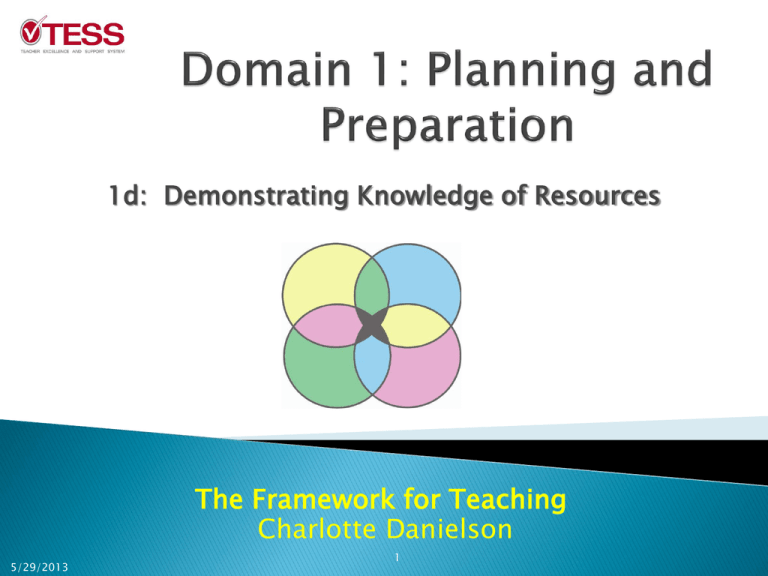
1d: Demonstrating Knowledge of Resources The Framework for Teaching Charlotte Danielson 5/29/2013 1 Understand the elements of 1d Distinguish the difference in Levels of Performance Review examples of 1d behavior Identify my level of performance on 1d Incorporate strategies to improve my level of performance in 1d 2 Revised 5/29/2013 Student learning is enhanced by a teacher's skillful use of resources. Some of these are provided by the school as "official" materials; others are secured by teachers through their own initiative. Student learning is enhanced by a teacher's skillful use of resources. 3 Revised 5/29/2013 Resources fall into several different categories: those used in the classroom by students those available beyond the classroom walls to enhance student learning resources for teachers to further their own professional knowledge and skill resources that can provide non-instructional assistance to students. 4 Revised 5/29/2013 Teachers recognize the importance of discretion in the selection of resources, selecting those that align directly with the learning outcomes and will be of most use to the students. Accomplished teachers also ensure that the selection of materials and resources is appropriately challenging for every student; texts at various reading levels ensure all students can gain full access to content for successful understanding of learning outcomes. Expert teachers look beyond the school for resources to bring their subjects to life and to assist students who need help in both their academic and nonacademic lives. 5 Revised 5/29/2013 1. Resources for classroom use Materials must align with learning outcomes. 2. Resources to extend content knowledge and pedagogy Materials that further teachers' professional knowledge must be available. 3. Resources for students Materials must be appropriately challenging. 6 Revised 5/29/2013 Materials provided by the district Materials provided by professional organizations A range of texts Internet resources Ongoing participation by the teacher in professional education courses or professional groups Guest speakers 7 Revised 5/29/2013 The teacher keeps careful records of students' progress in understanding fractions. Not Relevant-4b Maintaining Accurate Records At a school fair, the teacher presents a portfolio of his students' work. Not Relevant -3d Using Assessment in Instruction The teacher researches and identifies Internet sites appropriate for students to conduct research for their term papers. During class, the teacher gives them access to these sites. Relevant – describes resources for student learning 8 Revised 5/29/2013 You will read four classroom observation descriptions. Arrange four descriptions in order and indicate the order by writing on a post-it the performance level you would assign it and why (ex. A-1 because it says no preparation). After all four, compare with your table and discuss specific reasons why you rated it as you did. 9 Revised 5/29/2013 A. The teacher displays some awareness of resources beyond those provided by the school or district for classroom use and for extending one's professional skill but does not seek to expand this knowledge. 10 Revised 5/29/2013 B. The teacher is unaware of resources to assist student learning beyond materials provided by the school or district, nor is the teacher aware of resources for expanding one's own professional skill. 11 Revised 5/29/2013 C. The teacher's knowledge of resources for classroom use and for extending one's professional skill is extensive, including those available through the school or district, in the community, through professional organizations and universities, and on the Internet. 12 Revised 5/29/2013 D. The teacher displays awareness of resources beyond those provided by the school or district, including those on the Internet, for classroom use and for extending one's professional skill, and seeks out such resources. 13 Revised 5/29/2013 A. B. C. D. Level 2 (Basic) Level 1 (Unsatisfactory) Level 4 (Distinguished) Level 3 (Proficient) Any surprises? 14 Revised 5/29/2013 Texts are at varied levels. Texts are supplemented by guest speakers and field experiences. The teacher facilitates the use of Internet resources. Resources are multidisciplinary. The teacher expands her knowledge through professional learning groups and organizations. The teacher pursues options offered by universities. The teacher provides lists of resources outside the classroom for students to draw on. 15 Revised 5/29/2013 The teacher uses materials in the school library but does not search beyond the school for resources. The teacher participates in content-area workshops offered by the school but does not pursue other professional development. The teacher locates materials and resources for students that are available through the school but does not pursue any other avenues. 16 Revised 5/29/2013 The teacher uses only district-provided materials, even when more variety would assist some students. The teacher does not seek out resources available to expand her own skill. Although the teacher is aware of some student needs, he does not inquire about possible resources. 17 Revised 5/29/2013 In addition to the characteristics of a level of performance 3, Texts are matched to student skill level. The teacher has ongoing relationships with colleges and universities that support student learning. The teacher maintains a log of resources for student reference. The teacher pursues apprenticeships to increase discipline knowledge. The teacher facilitates student contact with resources outside the classroom. 18 Revised 5/29/2013 The teacher is not happy with the out-of-date textbook; his students will critique it and write their own material for social studies. The teacher spends the summer at Dow Chemical learning more about current research so that she can expand her knowledge base for teaching chemistry. The teacher matches students in her Family and Consumer Science class with local businesses; the students spend time shadowing employees to understand how their classroom skills might be used on the job. 19 Revised 5/29/2013 The teacher provides her fifth graders a range of nonfiction texts about the American Revolution so that regardless of their reading level, all students can participate in the discussion of important concepts. The teacher takes an online course on literature to expand her knowledge of great American writers. The ELA lesson includes a wide range of narrative and informational reading materials. The teacher distributes a list of summer reading materials that will help prepare his eighth graders' transition to high school. 20 Revised 5/29/2013 For a unit on ocean life, the teacher really needs more books, but the school library has only three for him to borrow. He does not seek out others from the public library. The teacher knows she should learn more about literacy development, but the school offered only one professional development day last year. The teacher thinks his students would benefit from hearing about health safety from a professional; he contacts the school nurse to visit his classroom. In the second-grade math class, the teacher misuses base 10 blocks in showing students how to represent numbers. 21 Revised 5/29/2013 For their unit on China, the students find all of their information in the district-supplied textbook. The teacher is not sure how to teach fractions but doesn't know how he's expected to learn it by himself. A student says, "It's too bad we can't go to the nature center when we're doing our unit on the environment." In the literacy classroom, the teacher has provided only narrative works. 22 Revised 5/29/2013 Do your unit plans and lesson plans identify materials and resources? Are there multiple types of materials and resources listed? Do you identify where these materials come from? Do you offer a wide variety of materials in your classroom that target students' particular learning needs? 23 Revised 5/29/2013 Do you keep records of guest speakers in the classroom and/or field trips taken by the students? Do you integrate lessons and units that you find beyond the textbook and align them to the learning needs of students? Do you keep notes from workshops and other professional learning offered outside of the school? 24 Revised 5/29/2013 How do you find resources to use in the classroom? What types of resources do you use? Why do you select these resources? How do you go beyond the textbook to enrich the learning experience for your students? 25 Revised 5/29/2013 How do you know if these resources are appropriately aligned to the learning outcomes? How do you help students get access to the resources available in the school, the community, and the district? 26 Revised 5/29/2013 Have you had any guest speakers visit the classroom? Why? Have you taken the students on any field trips? Why? 27 Revised 5/29/2013 What workshops and professional learning experiences have you engaged in recently? Where were these held? Why did you choose them? What blogs, websites, books, and/or articles do you use to enhance your professional learning? 28 Revised 5/29/2013 How did you come up with this lesson? What resources did you use? What resources and/or materials will students use during the lesson? Why? How do you know these resources and materials are appropriate for this lesson? If students need additional materials or resources, where will they get them? 29 Revised 5/29/2013 The degree to which your students are using a variety of materials in the lesson Evidence that these materials will help students better achieve the learning objectives Whether additional materials and resources are on display and available to students Whether you have provided students with lists of resources in the community or online that can help them achieve their learning goals. 30 Revised 5/29/2013 After reviewing the Performance Levels for Domain 1d: Demonstrating Knowledge of Resources, explain some resources that you use to enhance your lessons. 31 Revised 5/29/2013
